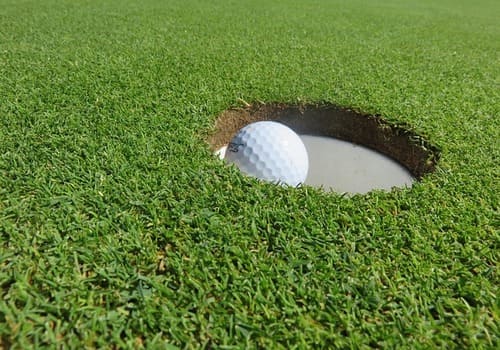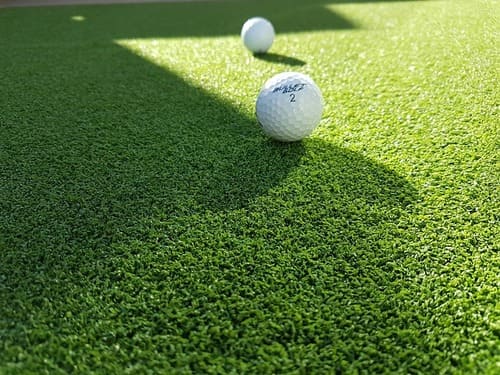Fore! Have you ever found yourself standing on the lush, pristine fairways of a golf course, taking in the fresh air, and pondering the mysteries of the golfing world? If you have, you’re not alone. Golfers are known for their passionate pursuit of perfection, and that includes understanding every facet of the game. Today, we’re delving deep into the golf greens, or should we say, the grass, in our quest to unravel the secrets of those velvety-smooth putting surfaces.
So, whether you’re a seasoned golfer, an aspiring pro, or just curious about what goes into making a golf course the envy of all, it’s time to tee off on the ultimate journey to discover – “What Grass Is Used On Golf Greens?” Grab your clubs and let’s take a swing at this intriguing topic!
Types of Grass Used on Golf Greens
When it comes to golf greens, the selection of grass plays a crucial role in ensuring optimal playing conditions. Different types of grass are employed on golf courses depending on various factors such as climate, location, and maintenance requirements. One popular grass used on golf greens is bentgrass. Known for its fine texture and ability to withstand heavy foot traffic, bentgrass provides a smooth and consistent playing surface. Its dense mat also helps promote ball roll and creates a uniform appearance across the green.
Another common grass variety found on golf greens is Bermuda grass. This warm-season grass thrives in hotter climates and requires ample sunlight for its growth. Bermuda grass’s durability and resistance to wear and tear make it an ideal choice for golf courses with high play levels. Its ability to recover quickly from damage, such as divots or ball marks, ensures consistent playing conditions. The dense and tightly knit structure of Bermuda grass also helps prevent weed growth and provides an attractive green surface.
Different Grass Varieties Found on Golf Greens
Bentgrass is one of the most popular grass varieties used on golf greens. It is known for its fine texture and dense growth, which allows for a smooth and consistent playing surface. Bentgrass is also highly tolerant to low mowing heights and recovers quickly from wear and tear. Its adaptability to different climates and its ability to withstand stress make it a top choice for many golf course superintendents.
Another common grass variety found on golf greens is Bermuda grass. This warm-season grass is known for its excellent heat and drought tolerance, making it ideal for golf courses in hot and arid regions. Bermuda grass also has a fast growth rate and a high wear tolerance. This allows for quick recovery from heavy foot traffic. It has a dense growth pattern and the ability to withstand low mowing heights. These contribute to the creation of smooth and fast putting surfaces.
Choosing the Right Grass for Golf Greens
When it comes to choosing the right grass for golf greens, there are several factors that need to be considered. One of the key considerations is the climate and weather conditions of the golf course location. Different grass varieties thrive in different climates, so it is important to choose a grass type that is well-suited for the specific location.
Another important factor to consider is the level of maintenance that the grass requires. Some grass varieties are more high-maintenance and require regular mowing, fertilizing, and irrigation, while others are more low-maintenance and can withstand variations in watering and mowing frequency. The decision on the right grass type should be based on the resources and maintenance capabilities of the golf course.

Key Considerations When Selecting Grass for Golf Greens
When selecting the appropriate grass for golf greens, several key considerations need to be taken into account. Firstly, the climate and weather conditions of the golf course’s location must be analyzed. Certain grass varieties thrive in warm or cool climates, while others are more tolerant to extreme weather conditions. It is crucial to choose a grass species that can withstand the specific temperature, rainfall, and sunlight patterns of the region.
Moreover, the desired playability and performance of the golf greens must also be considered. Different grass types offer varying textures, growth patterns, and ball roll characteristics. For instance, some grass varieties provide a firmer and faster playing surface, while others offer more resilience and better ball control. The overall goal is to select a grass that balances playability, aesthetics, and maintenance requirements. This is to meet both the golfer’s expectations and the course’s standards.
The Role of Grass in Golf Course Maintenance
Grass plays a crucial role in golf course maintenance, particularly on the greens. The type of grass used on golf greens can greatly affect the playability and overall experience for golfers. It creates a smooth and consistent surface, allowing the ball to roll true and predictably.
In addition to providing a suitable surface for golfers, the grass on golf greens also helps with moisture management. By absorbing and circulating water, the grass prevents water from accumulating on the surface, which would make the greens unplayable. Proper grass maintenance, such as regular mowing and aerating, helps to promote healthy growth and ensure that the greens remain in optimal condition throughout the golfing season.
Factors That Influence Grass Selection for Golf Greens
The selection of grass for golf greens is a vital decision that can significantly impact the overall quality and playability of the course. Several factors come into play when determining which grass variety to use. Climate and weather conditions are among the primary considerations.
Different grass species thrive in different climates, and selecting a grass that can withstand the local weather extremes is crucial for maintaining a healthy and lush green. Other factors like sunlight exposure, soil type, and water availability must also be taken into account. This ensures optimal growing conditions for the chosen grass variety.
The requirements of the golf course and the specific needs of the players are also influential factors in grass selection. Golf greens should provide a smooth and consistent surface for putting, requiring close attention to the grass’s characteristics. Such as density, texture, and growth habit.
Some grass types are better suited for achieving the desired playing qualities, offering excellent ball roll and predictable speed, while others may fall short. Taking into consideration the preferences and expectations of the golfers who play on the green is essential in making the right grass selection for golf greens.
Comparing Different Grass Species for Golf Greens
Bermuda grass and bentgrass are two popular choices when it comes to grass species for golf greens. Bermuda grass is known for its heat tolerance and ability to withstand heavy traffic, making it a favorite in warmer climates. It has a medium texture and provides a smooth surface for putting. On the other hand, bentgrass is a cool-season grass that thrives in cooler climates. It has a fine texture and is known for its dense, carpet-like appearance. Bentgrass provides excellent recovery and is highly resistant to disease, making it a popular choice for golf greens.
When comparing these grass species for golf greens, there are a few key differences to consider. Bermuda grass tends to have a faster growth rate compared to bentgrass, which means it requires more frequent mowing and maintenance.
Additionally, Bermuda grass may require more water and fertilization to maintain its optimal condition. On the other hand, bentgrass requires more attention to disease prevention and may struggle in hot and humid climates. Overall, the choice between these grass species will depend on factors such as climate, golf course traffic, and maintenance capabilities.

Maintenance Techniques for Golf Green Grass
To maintain optimal conditions on golf greens, proper maintenance techniques must be employed. One vital technique is mowing the grass at the appropriate height. Consistently cutting the grass to a uniform height ensures an even playing surface and promotes healthy growth. Additionally, regular aeration is crucial for golf green grass maintenance. By creating small holes in the soil, aeration allows oxygen, water, and nutrients to penetrate the roots, promoting better overall turf health. These techniques, among others, play a significant role in upholding the quality and playability of golf greens.
However, it is essential to note that maintenance techniques may vary depending on the type of grass used. While some grass varieties require strict mowing schedules, others may have different irrigation needs. Similarly, certain grass species may necessitate specialized fertilization or weed control techniques. Understanding the specific maintenance requirements of the chosen grass is vital for effectively caring for golf greens. By implementing the appropriate techniques tailored to the specific grass variety, golf course managers can ensure the greens remain in top condition for players to enjoy.
Tips for Keeping Golf Greens in Optimal Condition
To keep golf greens in optimal condition, regular mowing is essential. It is recommended to mow the grass at least once a day during peak growing seasons, such as spring and summer. This helps maintain the desired height and promotes healthy growth. However, it is crucial to avoid cutting the grass too short, as this can weaken the turf and make it more susceptible to diseases and pests.
In addition to regular mowing, proper watering is necessary to keep golf greens healthy. The key is to provide adequate water without overwatering. Irrigation systems with adjustable sprinkler heads can help distribute water evenly. It is important to water deeply but infrequently, allowing the soil to dry out between watering sessions. This encourages the root system to grow deeper, making the turf more drought-tolerant and resilient.
Common Challenges in Maintaining Golf Green Grass
One of the common challenges in maintaining golf green grass is the issue of weeds. Weeds can quickly infest and overtake a golf green, disrupting the smooth and uniform appearance of the playing surface. Additionally, weeds can compete with the grass for nutrients and water, affecting its health and overall condition. To combat this challenge, golf course managers must implement regular weed control measures such as herbicide application and proper maintenance practices like regular mowing and aeration.
Another challenge faced in maintaining golf green grass is the threat of diseases. Certain diseases, such as fungus and brown patch, can cause significant damage to the grass, leading to discoloration, thinning, and even death of the turf. These diseases thrive in conditions of high humidity, excessive moisture, and poor air circulation.
To address this challenge, golf course maintenance teams need to closely monitor the health of the grass, implement proper watering and drainage systems, and apply fungicides when necessary. Timely detection and proactive management are essential to prevent the spread of diseases and ensure the longevity of the golf green grass.

FAQs
What types of grass are commonly used on golf greens?
There are several types of grass that are commonly used on golf greens, including Bermuda grass, Bentgrass, and Poa annua.
What are the different grass varieties found on golf greens?
Some of the different grass varieties found on golf greens include Tifdwarf Bermuda grass, Penn
How do I choose the right grass for golf greens?
When choosing the right grass for golf greens, you should consider factors such as climate, soil type, maintenance requirements, and playability.
What are the key considerations when selecting grass for golf greens?
The key considerations when selecting grass for golf greens include disease resistance, tolerance to heavy foot traffic, adaptability to different climates, and performance under various maintenance practices.
What role does grass play in golf course maintenance?
Grass plays a crucial role in golf course maintenance as it provides a playable surface, reduces soil erosion, contributes to aesthetics, and helps regulate water drainage.
What factors influence grass selection for golf greens?
Factors that influence grass selection for golf greens include climate, soil conditions, desired playing characteristics, available maintenance resources, and budget constraints.
How do different grass species for golf greens compare?
Different grass species for golf greens have varying characteristics such as growth rate, drought tolerance, shade tolerance, and response to different maintenance practices. It is important to consider these factors when comparing grass species.
What maintenance techniques are recommended for golf green grass?
Recommended maintenance techniques for golf green grass include regular mowing, fertilization, aerating, topdressing, pest control, irrigation management, and overseeding.
What are some tips for keeping golf greens in optimal condition?
Some tips for keeping golf greens in optimal condition include proper watering and drainage, regular mowing at the appropriate height, timely fertilization, effective pest and weed control, and regular soil testing.
What are some common challenges in maintaining golf green grass?
Some common challenges in maintaining golf green grass include disease outbreaks, weed infestation, excessive thatch buildup, poor drainage, compaction, shade problems, and the need for frequent irrigation.






